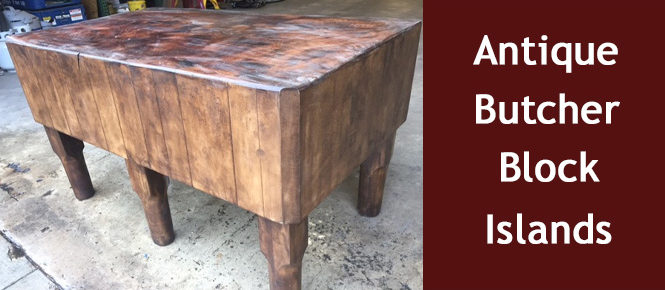 Antique Butcher Blocks
Antique Butcher Blocks
Plain and simple, our affinity towards butcher blocks was born out of a fascination with early American craftsmanship. My first real appreciation with this came when my father took an abandoned stove foundry and converted it into a cotton warehouse. Seeing the exactness of those stove foundry patterns, built from scratch out of wood, understanding how they fit into the sand cast molding process, was and still is fascinating. It was a pure form of craftsmanship.
Butcher blocks are the same kind of craftsmanship. Consider their construction; they are all made of long pieces of end grain hard maple, and the tolerances in assembly are exacting. The joinery has to be perfect. Some are even put together with tongue and groove joinery, some with a double dovetail (yes those dovetails go all the way thru the block). Then they were then bored on the sides (all the way through the block) and threaded rods (behind wood plugs or metal escutcheons) hold the block together. It’s pretty amazing to consider the design and execution of this working piece of furniture.
Some history: All of our blocks were made prior to 1951 (the government banned their use because some wouldn’t clean them properly).The big mass marketers in the late 1800’s/early 1900’s were Michigan Maple Block Company out of Petosky, Michigan, Bally Block out of Bally, Pennsylvania (they merged in the 1920’s), and John Boos out of Effingham, Illinois south of Chicago. There were also some niche makers in Cincinnati and Cleveland. And they all competed on a quality of material and construction basis, so you had to turn out a pretty good product just to survive in that business. These manufacturers also sold their blocks by grade. Generally the thicker the block, the better the grade, and the more coveted the block. Some of these blocks even have a date stamp on the bottom of the block..
These are original butcher blocks and came out of slaughter houses, meat markets, and general stores, Their tops are rarely perfect but still full of charm. They show wear including the original “valleys” where a butcher stood at his work station on the specific corner of the block and cut meat for 30 plus years. On the bigger blocks, you can see as many as four valleys where each butcher had a corner to work.
About our finishes…when we get a block, since it’s original, it’s generally covered in a quarter inch of suet and fat. We clean them by sanding them. We sand them thrice, using the coarser grits to remove and clean, the finer grits to finish and smooth. Then we wash them with soap and water. We finish our blocks several ways. We stain and polish our blocks in different colors using the Bri Wax family of products, and on some, we use what they used originally: mineral oil for a natural look. You’ll find example of all these on the site, even blocks that are still “in process” of being finished. And don’t be bashful about asking us to finish one in a specific finish for you.
Today, Henry is the collector, the buyer, the seller, the delivery guy, the shipper, the chief bottle washer, everything..
We buy Antique Butcher Blocks too!
We like the larger blocks, mostly six legged, with special joinery, so feel free to contact us.
Unique, Historic and Antique Butcher Blocks
We sell and deliver unique, historic and Antique Butcher Blocks. Over the years, we have accumulated a wonderful collection of these unique kitchen islands. Adding one to your kitchen can help you to create that perfect balance between the new contemporary styles and the charm that comes from a historic piece of furniture. Our firm offers delivery service and can have your butcher block to you within just days of your order.
Phone: 404-310-6490 (please call between 8 am-8 pm Eastern Standard Time)




